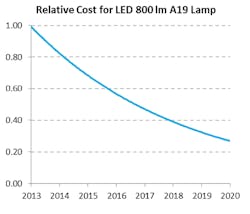The US Department of Energy has charted an SSL technology course intended to deliver in excess of 200 lm/W at the luminaire or lighting-system level by 2025.
US Department of Energy (DOE) has published the 2016 Solid-State Lighting (SSL) R&D Plan that charts the course forward for continued improvement in both LED and OLED light sources. This year, the DOE suggested that the most aggressive technology assumptions would deliver a 60% reduction in site electricity consumption by 2030. Moreover, the agency said controls and evolving SSL components and systems will deliver significant improvement in the quality and value of lighting.
Interested in articles & announcements on LED & OLED technology?
The SSL R&D Plan was first published in 2015 and was a combination of the prior Multi-Year Program Plan (MYPP) and SSL Manufacturing Roadmap documents that had been published prior to 2015. The DOE intends to influence the direction of the development of LED and OLED technology over the following three to five years via the annual publication.
The ultimate goal of the DOE SSL program is energy reduction, and the projected savings remain consistent in 2016 relative to the prior year. Relative to a non-LED scenario, site electricity savings will be reduced by 40% in 2030 — a 261 TWh (terawatt-hour) reduction. But should the industry progress on the initiatives defined in the R&D plan, the DOE says that reductions could hit 60%. The DOE equates that level of savings to being more than double the projected power produced by wind, and 20 times more than the power produced by solar.
Among the research areas identified as having the potential to accelerate savings, the DOE tabbed emitter and down-converter or phosphor materials. The agency said research must address current density, thermal droop, red and green LED efficiency, and red thermal stability in emitters. The focus in down-converter materials will be on narrowing emission bands or what are called narrow linewidth materials.
The DOE also called for improvements in LED drivers both for efficiency and lighting quality. The agency said minimizing flicker is a concern, and drivers must evolve to deliver peak efficiency across the dimming or tuning range of luminaires and not just at full output. The report does not use the term human-centric lighting (HCL), but the DOE also called on the SSL sector to better understand the human physiological response to light and to develop products that can improve wellbeing, increase productivity, and minimize negative impacts of artificial light.
In the OLED area, the top R&D targets are materials and light extraction. Research in both areas could help close the efficacy gap between LEDs and OLEDs. Moreover, the DOE said more work is needed in controlling OLED beam patterns in the light extraction process.
Of course, OLED cost remains an issue. The DOE said manufacturing yields must be improved and reliability of OLED systems remains an issue that must be solved. The report charts each of the areas mentioned relative to LEDs and OLEDs in detail with guidance for the industry in overcoming the various challenges.
The DOE also included data that essentially justifies the existence of the SSL program and the use of taxpayer dollars to fund the effort including grants to many companies for research. A chart projects that without the DOE funding, luminaire efficacy would stall at just over 100 lm/W by 2025 as opposed to the 200-lm/W goal of the program.
While the DOE is clearly focused on the US, the SSL program has clearly impacted the maturity and adoption of SSL worldwide. Indeed, many facets of the program have directly led to better quality products such as the well known L-Prize program for retrofit lamps, an award won by Philips Lighting. The L-Prize lamps program showed that highly-efficient lamps could be designed and manufactured with light quality near that of incandescent bulbs but with lifetimes in the 50,000-hour range. And the DOE has a chart showing that LED lamp prices will drop by 70% between 2013 and 2020.
We have covered the full range of DOE reports and programs over many years. The last MYPP report was published in May of 2014. The last LED and OLED Manufacturing Roadmap was published in August of 2014. You can access the latest full DOE report on their SSL website.






